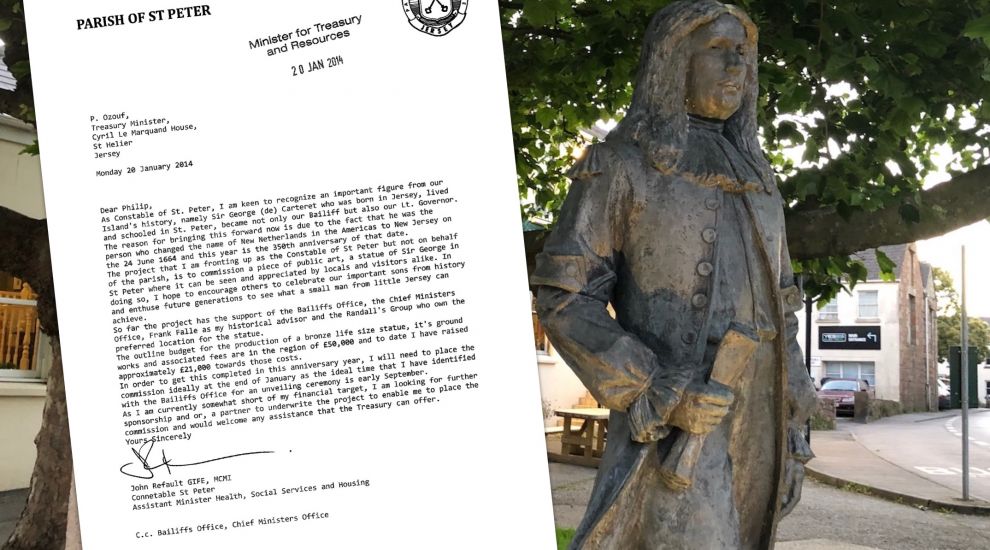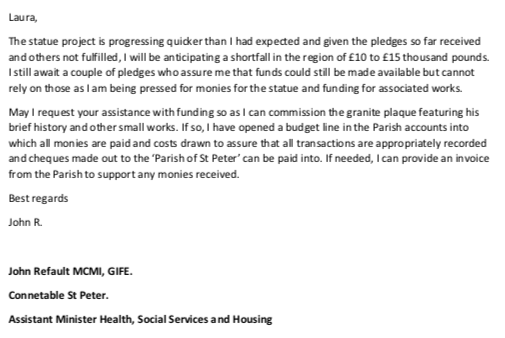


The island’s Treasury was called in to help pay the bill for the Sir George Carteret statue after a “shortfall” in donations led to a £15k funding gap, correspondence unearthed by Express has revealed.
The bronze figure was erected in St. Peter in 2014 to commemorate the 350th anniversary of the founding of New Jersey.
While it was supposed to have been predominantly funded by private donations, it recently emerged that more than £36,000 in public funds had been contributed towards the statue, with no specific due diligence undertaken.
The current Treasury Minister said the contribution was to show the government’s support for the 350th anniversary celebration.
Meanwhile the driving force behind the statue, former St. Peter Constable and Assistant Minister John Refault, previously told Express the contributions were appropriate because the then Chief Minister Senator Ian Gorst and Treasury Minister Senator Philip Ozouf “were very keen on building business and cultural links with New Jersey, and this fitted in perfectly with that.”
Video: The unveiling of the statue.
However, it’s now emerged that the Treasury only got involved to plug a £15,000 gap when donations to the project fell short while the progress on the statue and linked anniversary celebrations were already underway.
A letter released following a request under the Freedom of Information (FOI) Law by Express shows how Constable Refault first wrote to the Treasury Minister in January 2014 to ask for help.
Detailing the project’s estimated £50,000 cost, he added that a commission would have to be placed by the end of the month in order for it to be ready on time for a September unveiling.
However, the Constable noted he was “currently short of my financial target”, stating: “I am looking for further sponsorship and or, a partner to underwrite the project to enable me to place the commission and would welcome any assistance that the Treasury can offer.”
Pictured: The letter written by Constable John Refault to the Treasury Minister. (CLICK to enlarge)
In April, the Constable wrote directly to the then-Treasurer, Laura Rowley, warning that a number of donations had not come through.
He wrote: “The statue project is progressing quicker than I had expected and given the pledges so far received and others not fulfilled, I will be anticipating a shortfall in the region of £10 to £15 thousand pounds. I still await a couple of pledges who assure me that funds could still be made available but cannot rely on those as I am being pressed for monies for the statue and funding for associated works.
“May I request your assistance with funding so as I can commission the granite plaque featuring his brief history and other small works. If so, I have opened a budget line in the Parish accounts into which all monies are paid and costs drawn to assure that all transactions are appropriately recorded and cheques made out to the ‘Parish of St Peter’ can be paid into. If needed, I can provide an invoice from the Parish to support any monies received.”

Pictured: An email sent by Constable Refault in April to Treasurer Laura Rowley.
To this, Ms Rowley replied that £15,000 would be released. In return, Constable Refault thanked her, adding: “Should there be a surplus at the end of the project, I will do course advise you and make those surplus funds repayable to Treasury.”
The news comes as debate continues over the appropriateness of the statue and whether it should be removed, given that Sir George was a trader of enslaved people. It was covered in white paint by protestors following Jersey's Black Lives Matter protest.
According to public art specialist Chris Clifford, there are many lessons to be learned from the saga around the commissioning of community art features.
“This embarrassment could have been easily avoided if the project had been properly planned. The successful projects that I have been involved with, such as the St. Helier First World War memorial, have had a community focus and a proper artist and design selection process from the outset,” he previously told Express.

Pictured: Chris Clifford runs the Jersey-based gallery and art consultancy Public and Private.
“By thinking about location, materials, design, educational value, who can get involved and what is the lasting impact, you avoid the problems of having a statue of someone responsible for the deaths of 44,000 African slaves sculpted in a 19th century style which is inappropriate, out of date, and in the wrong location. I hope future projects, especially ones funded by the public, are done differently.”
Comments
Comments on this story express the views of the commentator only, not Bailiwick Publishing. We are unable to guarantee the accuracy of any of those comments.